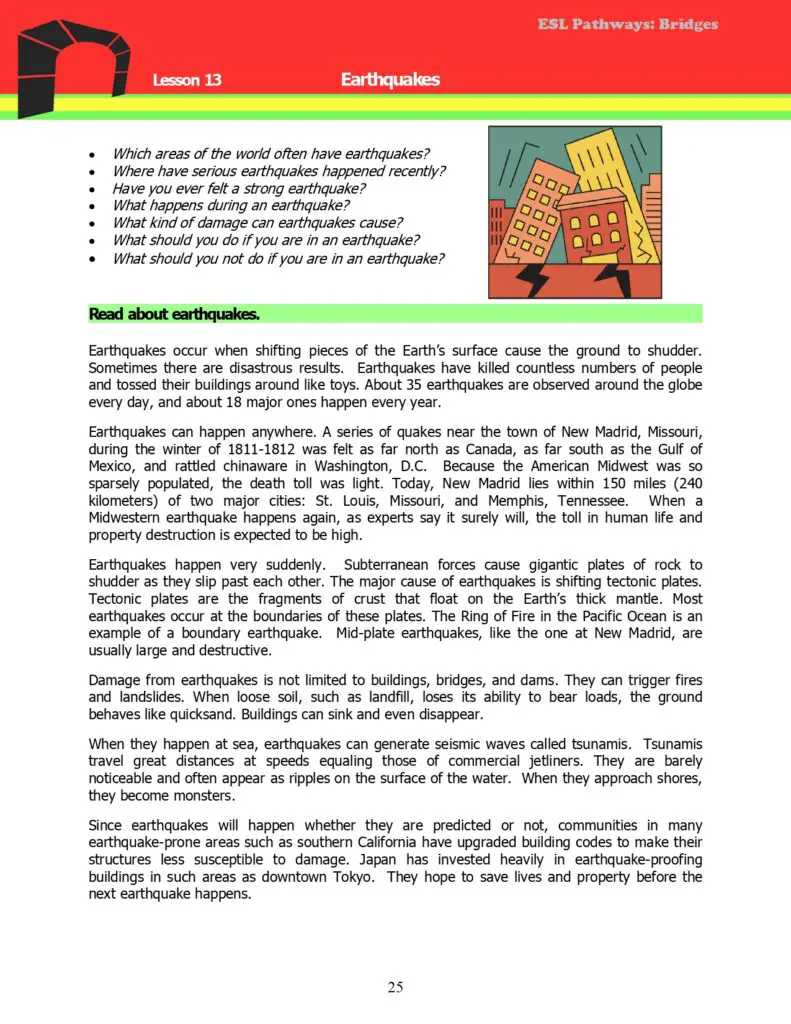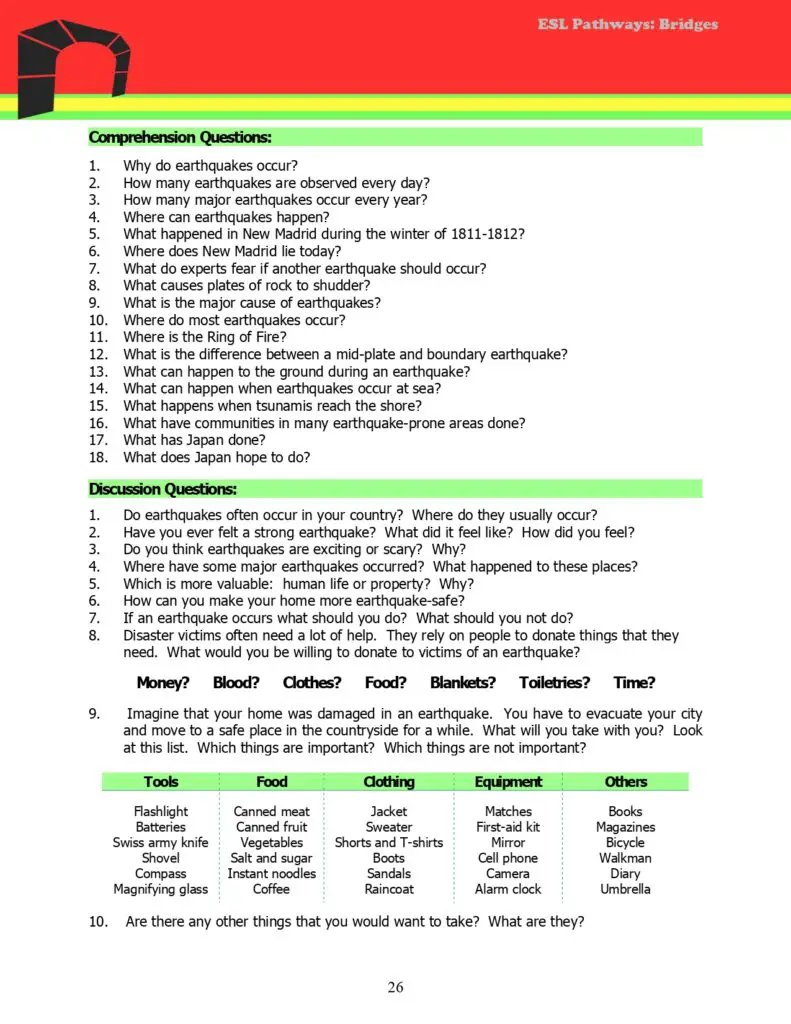This is Lesson 13, “Earthquakes,” from our collection of intermediate-level adult ESL lessons. The lesson features a reading passage about earthquakes, followed by comprehension questions and discussion questions. This content-packed lesson is written with relatively simple English to help students transition to a more advanced level of English understanding and fluency. This lesson is available for free download, and you can download many other adult ESL lessons like this one in our book ESL Pathways: Bridges.


ADULT ESL LESSONS: Earthquakes (Text-Only Version)
- Which areas of the world often have earthquakes?
- Where have serious earthquakes happened recently?
- Have you ever felt a strong earthquake?
- What happens during an earthquake?
- What kind of damage can earthquakes cause?
- What should you do if you are in an earthquake?
- What should you not do if you are in an earthquake?
Read about earthquakes.
Earthquakes occur when shifting pieces of the Earth’s surface cause the ground to shudder. Sometimes there are disastrous results. Earthquakes have killed countless numbers of people and tossed their buildings around like toys. About 35 earthquakes are observed around the globe every day, and about 18 major ones happen every year.
Earthquakes can happen anywhere. A series of quakes near the town of New Madrid, Missouri, during the winter of 1811-1812 was felt as far north as Canada, as far south as the Gulf of Mexico, and rattled chinaware in Washington, D.C. Because the American Midwest was so sparsely populated, the death toll was light. Today, New Madrid lies within 150 miles (240 kilometers) of two major cities: St. Louis, Missouri, and Memphis, Tennessee. When a Midwestern earthquake happens again, as experts say it surely will, the toll in human life and property destruction is expected to be high.
Earthquakes happen very suddenly. Subterranean forces cause gigantic plates of rock to shudder as they slip past each other. The major cause of earthquakes is shifting tectonic plates. Tectonic plates are the fragments of crust that float on the Earth’s thick mantle. Most earthquakes occur at the boundaries of these plates. The Ring of Fire in the Pacific Ocean is an example of a boundary earthquake. Mid-plate earthquakes, like the one at New Madrid, are usually large and destructive.
Damage from earthquakes is not limited to buildings, bridges, and dams. They can trigger fires and landslides. When loose soil, such as landfill, loses its ability to bear loads, the ground behaves like quicksand. Buildings can sink and even disappear.
When they happen at sea, earthquakes can generate seismic waves called tsunamis. Tsunamis travel great distances at speeds equaling those of commercial jetliners. They are barely noticeable and often appear as ripples on the surface of the water. When they approach shores, they become monsters.
Since earthquakes will happen whether they are predicted or not, communities in many earthquake-prone areas such as southern California have upgraded building codes to make their structures less susceptible to damage. Japan has invested heavily in earthquake-proofing buildings in such areas as downtown Tokyo. They hope to save lives and property before the next earthquake happens.
Comprehension Questions:
- Why do earthquakes occur?
- How many earthquakes are observed every day?
- How many major earthquakes occur every year?
- Where can earthquakes happen?
- What happened in New Madrid during the winter of 1811-1812?
- Where does New Madrid lie today?
- What do experts fear if another earthquake should occur?
- What causes plates of rock to shudder?
- What is the major cause of earthquakes?
- Where do most earthquakes occur?
- Where is the Ring of Fire?
- What is the difference between a mid-plate and boundary earthquake?
- What can happen to the ground during an earthquake?
- What can happen when earthquakes occur at sea?
- What happens when tsunamis reach the shore?
- What have communities in many earthquake-prone areas done?
- What has Japan done?
- What does Japan hope to do?
Discussion Questions:
- Do earthquakes often occur in your country? Where do they usually occur?
- Have you ever felt a strong earthquake? What did it feel like? How did you feel?
- Do you think earthquakes are exciting or scary? Why?
- Where have some major earthquakes occurred? What happened to these places?
- Which is more valuable: human life or property? Why?
- How can you make your home more earthquake-safe?
- If an earthquake occurs what should you do? What should you not do?
- Disaster victims often need a lot of help. They rely on people to donate things that they need. What would you be willing to donate to victims of an earthquake?
Money? Blood? Clothes? Food? Blankets? Toiletries? Time?
- Imagine that your home was damaged in an earthquake. You have to evacuate your city and move to a safe place in the countryside for a while. What will you take with you? Look at this list. Which things are important? Which things are not important?
|
Tools |
Food |
Clothing |
Equipment |
Others |
|
Flashlight Batteries Swiss army knife Shovel Compass Magnifying glass |
Canned meat Canned fruit Vegetables Salt and sugar Instant noodles Coffee |
Jacket Sweater Shorts and T-shirts Boots Sandals Raincoat |
Matches First-aid kit Mirror Cell phone Camera Alarm clock
|
Books Magazines Bicycle Walkman Diary Umbrella |
- Are there any other things that you would want to take? What are they?







